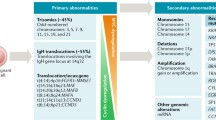Abstract
Association of immunoglobulin isotypes with survival in the context of modern prognostic factors has not been determined. We utilized the Flatiron Health Electronic Health Record database and identified 8468 MM patients. Compared to IgG MM, patients with IgA MM were more likely to have ISS-III, anemia, and t(4;14), and light chain (LC) MM had higher renal dysfunction and t(11;14). IgA and LC MM patients have an inferior OS. The adverse prognostic impact of IgA and LC isotypes on OS persisted even after adjustment for variables impacting outcomes and likely suggests their unique biology beyond the presence of adverse prognostic factors.

Similar content being viewed by others
References
Li Z, Woo CJ, Iglesias-Ussel MD, Ronai D, Scharff MD (2004) The generation of antibody diversity through somatic hypermutation and class switch recombination. Genes Dev 18:1–11
Kyle RA et al (2002) A long-term study of prognosis in monoclonal gammopathy of undetermined significance. N Engl J Med 346:564–569
Landgren O et al (2009) Monoclonal gammopathy of undetermined significance (MGUS) consistently precedes multiple myeloma: a prospective study. Blood 113:5412–5417
Kumar SK et al (2014) Continued improvement in survival in multiple myeloma: changes in early mortality and outcomes in older patients. Leukemia 28:1122–1128
Goldschmidt H et al (2018) Bortezomib before and after high-dose therapy in myeloma: long-term results from the phase III HOVON-65/GMMG-HD4 trial. Leukemia 32:383–390
Habermehl GK, Nakashima MO, Cotta CV (2020) IgA plasma cell neoplasms are characterized by poorer long-term survival and increased genomic complexity compared to IgG neoplasms. Annals of Diagnostic Pathology 44:151449
Wang L et al (2018) IgA type multiple myeloma, clinical features, and prognosis. Chin Med J (Engl) 131:1249–1250
Gemenetzi K et al (2016) Distinct immunogenetic signatures in IgA versus IgG multiple myeloma. Blood 128:2062–2062
Karlin L et al (2011) Clinical and biological features of t(4;14) multiple myeloma: a prospective study. Leuk Lymphoma 52:238–246
Arnulf B et al (2012) Prognostic value of the different MMSET gene breakpoints and correlation with immunoglobulin isotype and FGFR3 expression in 173 patients with t(4;14) multiple myeloma. Blood 120:3971–3971
Yadav P et al (2018) Cytogenetic aberrations in multiple myeloma are associated with shifts in serum immunoglobulin isotypes distribution and levels. Haematologica 103:e162–e164
Drayson M et al (2006) Effects of paraprotein heavy and light chain types and free light chain load on survival in myeloma: an analysis of patients receiving conventional-dose chemotherapy in Medical Research Council UK multiple myeloma trials. Blood 108:2013–2019
Cong X, Sun X, Qian L, Han Z (2004) Clinical analysis of 43 patients with light chain multiple myeloma. Chin J Clin Oncol 1:215–220
Author information
Authors and Affiliations
Contributions
SB, SG, and LC conceptualized the study, the study design, and the methodology; curated and analyzed the data; and performed the analyses, and SB, SG, KG, and LC perform the investigation, wrote the original draft of the article, and reviewed and edited it.
Corresponding author
Ethics declarations
Conflict of interest
SB has received research funding from Amyloid Foundation. SG is supported in part by the Walter B. Frommeyer Fellowship in Investigative Medicine at the University of Alabama at Birmingham and reports receiving research funding from Carevive Systems and Pack Health. KG does not have any relevant disclosures. LJC receives honoraria from Amgen, Bristol-Myers Squibb, AbbVie, and Janssen, and grant/research support from Amgen, Bristol-Myers Squibb, AbbVie, and Janssen.
Additional information
Publisher's note
Springer Nature remains neutral with regard to jurisdictional claims in published maps and institutional affiliations.
Supplementary Information
Below is the link to the electronic supplementary material.
277_2022_4783_MOESM1_ESM.pptx
Supplemental Figure 1. Derived progression free survival (dPFS) outcomes by immunoglobulin isotype. Kaplan–Meier curves showing comparison of dPFS for IgG, IgA, Light chain and other subgroups. (PPTX 169 KB)
277_2022_4783_MOESM2_ESM.pptx
Supplemental Figure 2. Overall survival outcomes by immunoglobulin isotype among patients underwent high dose therapy and autologous hematopoietic stem transplantation (AHCT). Kaplan–Meier curves showing comparison of overall survival (OS) for IgG, IgA, Light chain and other subgroups among patients who underwent AHCT. (PPTX 146 KB)
277_2022_4783_MOESM3_ESM.xlsx
Supplemental Table. Multivariable Analysis, ISS: International Staging System; ECOG: Eastern Cooperative Oncology Group; LDH: Lactate Dehydrogenase; ULN: Upper Limit Normal; Ch1a: Chromosome 1 Abnormalities; F: Female; M: Male; NHW: Non Hispanic White; NHB: Non Hispanic Black; Other: Biclonal and IgE MM; HR: Hazard Ratio (XLSX 12 KB)
Rights and permissions
About this article
Cite this article
Bal, S., Giri, S., Godby, K.N. et al. Revisiting the impact of immunoglobulin isotypes in multiple myeloma. Ann Hematol 101, 825–829 (2022). https://doi.org/10.1007/s00277-022-04783-1
Received:
Accepted:
Published:
Issue Date:
DOI: https://doi.org/10.1007/s00277-022-04783-1




